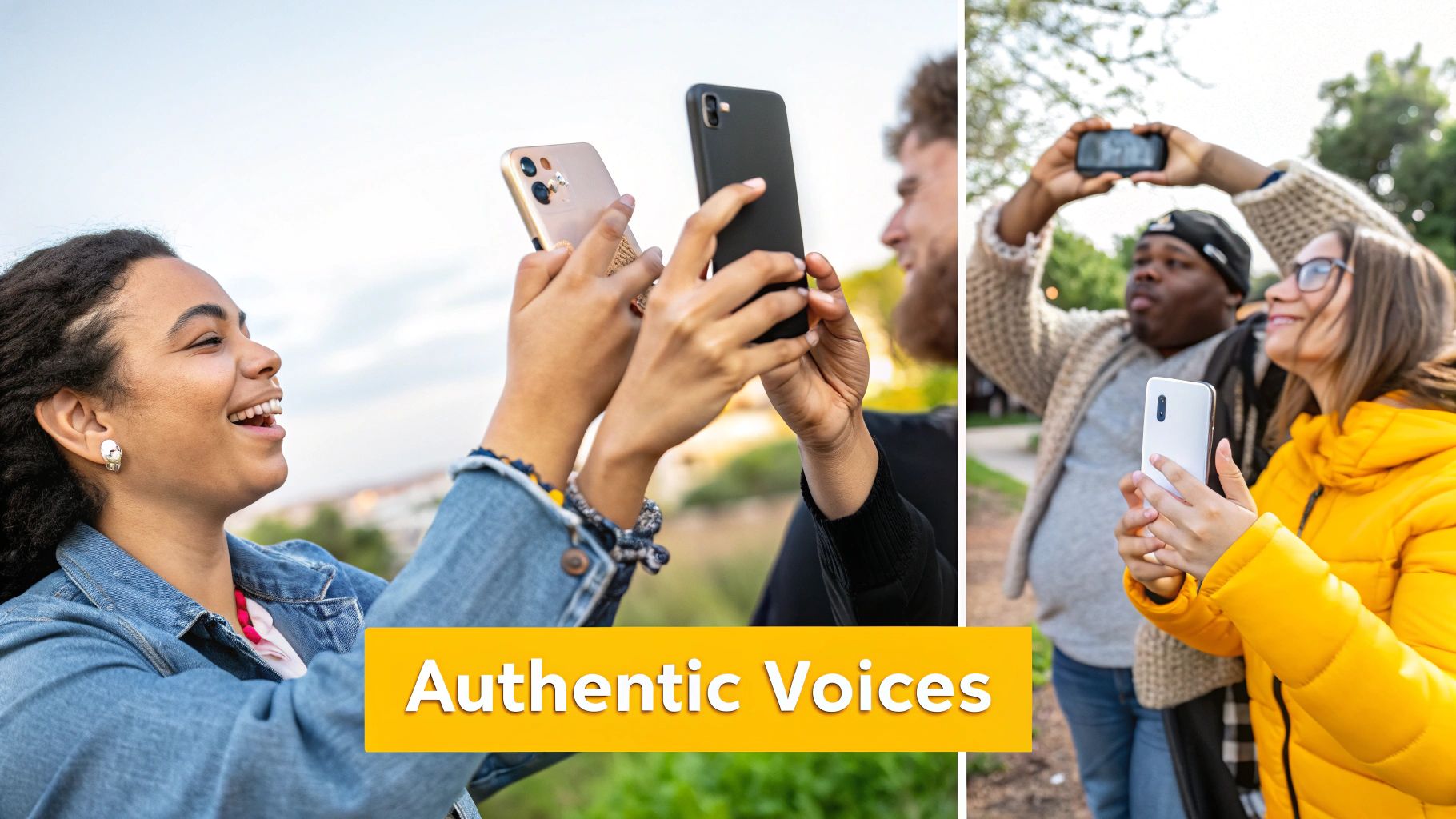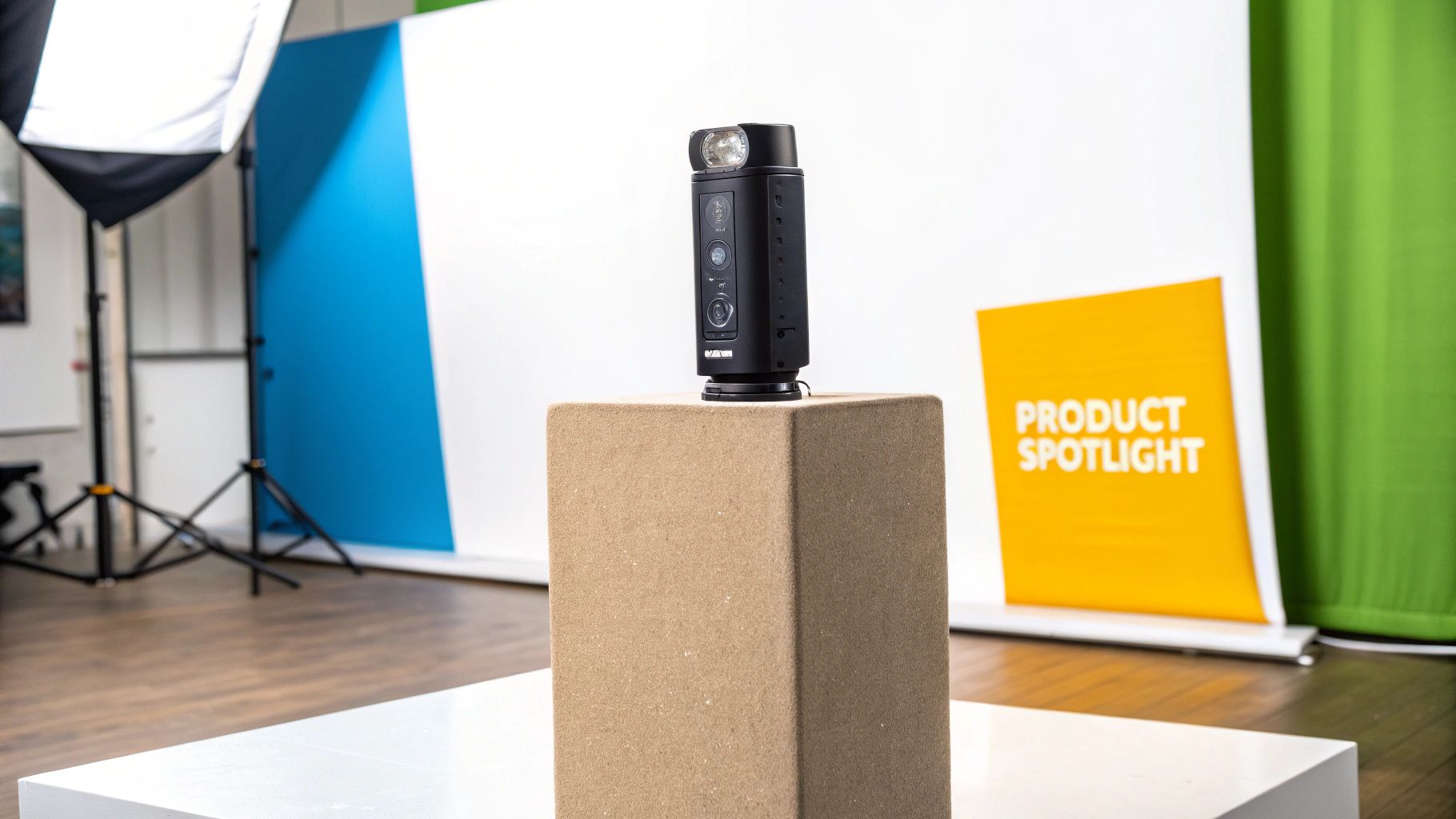10 Social Media Content Ideas to Go Viral in 2025

In the crowded digital landscape of 2025, generic posts no longer cut it. Your audience craves authenticity, value, and connection, meaning stale content can lead to stagnant growth and a brand that simply blends into the background. The key to breaking through the noise isn't just posting more often; it's about posting smarter with a clear, strategic purpose behind every update. This is where having a diverse and engaging toolkit of social media content ideas becomes essential for any business, from startups to established enterprises.
This guide provides 10 powerful and practical social media content ideas designed to stop the scroll, spark meaningful conversations, and build a loyal community around your brand. We'll move beyond the obvious, offering specific, platform-agnostic strategies with real-world examples and actionable steps you can implement immediately. For product managers, marketing teams, and CTOs, these concepts are crafted to enhance UX, amplify digital outreach, and support broader business goals. Whether you're aiming to make a splash or deepen engagement, these ideas will equip you with a fresh perspective and a robust content arsenal for the year ahead. Let's transform your social media from a simple broadcast channel into a dynamic hub for brand growth and customer interaction.
1. User-Generated Content (UGC)
Leveraging User-Generated Content (UGC) is one of the most powerful social media content ideas for building authentic brand credibility. This strategy involves showcasing content created by your customers, fans, and followers, such as photos, videos, reviews, or testimonials that feature your products or services. By highlighting genuine customer experiences, you transform your audience from passive consumers into active brand advocates.

UGC acts as powerful social proof, which significantly influences purchasing decisions. When potential customers see real people enjoying your offerings, it builds a level of trust that branded advertising simply cannot replicate. Think of GoPro, which built its entire marketing foundation on showcasing breathtaking adventure videos shot by its users. This approach not only provides a constant stream of fresh, engaging content but also fosters a strong sense of community. This method is a core pillar of modern digital outreach; you can learn more about how UGC fits into a broader strategy by exploring other content marketing techniques.
How to Implement UGC Effectively
- Create a Branded Hashtag: Launch a campaign with a unique, memorable hashtag. Encourage users to tag their posts for a chance to be featured. For example, Starbucks' annual
#RedCupContestgenerates millions of festive, user-submitted photos. - Always Ask for Permission: Before reposting any content, reach out to the original creator for their explicit permission. This respects their ownership and builds goodwill.
- Incentivize Participation: Offer prizes, discounts, or simply a feature on your official page as a reward. Acknowledging contributors makes them feel valued and encourages others to participate.
- Set Clear Guidelines: To ensure submissions align with your brand values, provide clear rules on what is acceptable and what is not.
2. Behind-the-Scenes Content
Pulling back the curtain with behind-the-scenes (BTS) content is a fantastic social media content idea for humanizing your brand and forging deeper connections. This approach involves sharing exclusive glimpses into your company's inner workings, showcasing the people, processes, and culture that customers don't normally see. By revealing the authentic, unfiltered side of your business, you transform your brand from a faceless entity into a relatable group of passionate individuals.

This transparency builds immense trust and loyalty. When followers see the effort, creativity, and care that go into your products or services, they develop a greater appreciation for your brand's value. For example, brands like Glossier frequently feature their employees and office culture, while companies such as Ben & Jerry's show their fascinating ice cream production process. This strategy provides an endless well of engaging material and makes your audience feel like insiders, strengthening their emotional investment in your success.
How to Implement Behind-the-Scenes Content Effectively
- Showcase Your Process: Take your audience on a journey from concept to creation. This could be a designer sketching a new logo, a developer coding a feature, or a chef testing a new recipe.
- Feature Your Team: Introduce the people who make your business run. Create recurring series like "Meet the Team" or a "Day in the Life" to highlight different roles and personalities.
- Be Authentic About Challenges: Don't just show the polished final product. Sharing the occasional struggle or "happy accident" makes your brand more genuine and relatable.
- Use Ephemeral Content: Leverage Instagram or Facebook Stories for casual, unscripted BTS moments. Their temporary nature is perfect for raw, in-the-moment updates that don't need to be highly polished.
3. Educational and How-To Content
Positioning your brand as an industry authority is a game-changer, and creating educational or how-to content is one of the best social media content ideas to achieve this. This strategy involves teaching your audience valuable skills or providing solutions to their problems. By offering genuine value beyond just your product, you build trust and establish a long-term relationship with your followers, making them more likely to turn to you when they are ready to purchase.

This approach shifts the focus from selling to helping, which resonates deeply with modern consumers. Brands like HubSpot excel at this by offering free marketing tutorials, while Home Depot empowers customers with DIY project guides. This content not only attracts an engaged audience but also addresses their pain points directly. When you consistently solve problems for your followers, your brand becomes an indispensable resource in their minds. You can find more inspiration for creating helpful content by exploring different types of articles that resonate with online audiences.
How to Implement Educational Content Effectively
- Address Common Questions: Use your customer service inquiries and social media comments as inspiration. Create content that directly answers the most frequently asked questions about your industry or products.
- Break Down Complex Topics: Transform intimidating subjects into simple, digestible steps. Use carousels, short videos, or infographics to explain complex processes in an easy-to-follow format.
- Use Visuals Heavily: Instructional content is most effective when it's visual. A quick video tutorial, like those made famous by Tasty, is often more engaging and easier to understand than a block of text.
- Create a Content Series: For comprehensive topics, develop a multi-part series. This encourages followers to return for subsequent installments, boosting retention and establishing your page as a go-to educational hub.
4. Interactive Content and Polls
Transforming passive scrollers into active participants is a key goal, and interactive content offers one of the most effective social media content ideas to achieve this. This approach includes polls, quizzes, open-ended questions, and challenges that directly invite audience participation. By prompting a direct response, you not only boost engagement metrics but also open a two-way dialogue with your followers.

Interactive formats are exceptionally powerful because they make your audience feel heard and valued. For example, brands like BuzzFeed built their empire on personality quizzes, while platforms like Instagram and Twitter have integrated polls and question stickers directly into their features. This type of content is not just for fun; it provides invaluable, real-time feedback and customer insights. When you ask followers to vote on a new product color or share their opinion on a topic, you gather market research data while simultaneously strengthening your community bond.
How to Implement Interactive Content Effectively
- Ask Relevant and Engaging Questions: Use Instagram Stories' question sticker to ask things like, "What's one feature you wish our app had?" or run a Twitter poll asking which blog topic they'd prefer to see next.
- Create Industry-Related Quizzes: Develop a short, fun quiz related to your niche. A financial services company could create a "What's Your Money Personality?" quiz to engage and educate users.
- Use Polls for Business Decisions: Involve your audience in minor business decisions, such as choosing a new t-shirt design or picking a theme for an upcoming sale. This transparency fosters loyalty.
- Acknowledge and Share Results: Always follow up by sharing poll results or featuring the best answers from a Q&A session. This closes the loop and shows participants that their input mattered.
5. Trending Topics and News Commentary
Capitalizing on trending topics is one of the most effective social media content ideas for boosting relevance and joining larger cultural conversations. This strategy involves tapping into current events, viral hashtags, and pop culture moments by providing your brand's unique perspective. By reacting to what people are already talking about, you can insert your brand into the zeitgeist, increase visibility, and showcase a timely, human side.
This approach demonstrates that your brand is current and connected. When done right, it can lead to massive engagement, as seen with Oreo's legendary "Dunk in the Dark" tweet during the Super Bowl blackout. It’s not just about jumping on a bandwagon; it’s about finding an authentic intersection between the trend and your brand's voice. To stay relevant and capitalize on popular platforms, keep an eye on evolving trends and explore specific Tiktok content ideas that align with your industry.
How to Implement News Commentary Effectively
- Act Quickly and Strategically: Trends have a short lifespan. Monitor social platforms to identify emerging topics early, but ensure they genuinely align with your brand's values before participating.
- Add a Unique Brand Perspective: Avoid simply reposting a trend. Instead, add your unique spin. For instance, Duolingo uses its mascot, Duo, to participate in TikTok trends with a humorous, language-learning twist.
- Maintain Authenticity: Forced participation is easy to spot and can damage your brand's credibility. If a trend doesn't feel right for your audience or message, it's better to sit it out.
- Establish Clear Approval Processes: For timely or sensitive topics, have a streamlined approval workflow in place to ensure your commentary is appropriate, on-brand, and well-received. Integrating this reactive content into a structured plan is crucial, which you can learn more about by reviewing a digital marketing plan template.
6. Product Showcases and Demonstrations
Creating detailed social media content ideas around product showcases and demonstrations is essential for translating audience interest into sales. This strategy moves beyond static product photos, focusing instead on dynamic content that shows your product in action. By highlighting how your product works, its key benefits, and the problems it solves, you educate potential customers and build their confidence to make a purchase.
This type of content directly supports sales goals by clearly communicating value. Think of how Dyson uses compelling videos to demonstrate the superior suction of its vacuums or how Apple's launch events meticulously walk through every new feature. These demonstrations make abstract benefits tangible and desirable. This approach is not just for physical products; software and app developers can use screen recordings and tutorials to guide users through their digital offerings, a key component of a robust mobile app marketing strategy.
How to Implement Product Showcases Effectively
- Focus on Benefits, Not Just Features: Instead of listing technical specifications, show how those features improve the user's life. For example, a camera's low-light capability becomes a video of capturing clear, beautiful nighttime cityscapes.
- Show, Don't Just Tell: Create high-quality videos, GIFs, or carousel posts that demonstrate the product being used in real-world scenarios. Unboxing videos, tutorials, and before-and-after content are highly effective formats.
- Use High-Quality Visuals: Professional-looking photos and videos are non-negotiable. Poor lighting or shaky camera work can make even the best product look unprofessional and untrustworthy.
- Create Comparison Content: Ethically and accurately compare your product to a competitor's or an older version to highlight its unique advantages and improvements.
7. Storytelling and Brand Narratives
Weaving Storytelling and Brand Narratives into your strategy is a transformative social media content idea that moves beyond simple promotion. This approach uses compelling narratives to share your brand’s history, values, mission, or customer successes. By telling stories, you create an emotional connection, making your brand more relatable and memorable to your audience.
Stories resonate because they tap into fundamental human emotions. Instead of just listing product features, a brand narrative shows the impact of those features on a real person's life. Consider Patagonia, a brand that doesn't just sell outdoor gear; it tells powerful stories about environmental activism and adventure, aligning its products with a greater purpose. This method helps your audience see the people and values behind the logo, fostering loyalty that transcends transactional relationships.
How to Implement Storytelling Effectively
- Focus on a Central Character: Every good story has a hero. This could be a customer overcoming a challenge, an employee dedicated to their craft, or even your founder on their entrepreneurial journey.
- Create a Narrative Arc: Structure your story with a clear beginning (the setup), middle (the conflict or journey), and end (the resolution). This classic structure keeps audiences engaged.
- Show, Don't Tell: Use visuals like photos and videos to bring your narrative to life. For example, Airbnb excels by sharing stories of hosts and travelers through visually rich content that showcases unique experiences.
- Connect to Core Values: Ensure every story reinforces what your brand stands for. Dove’s "Real Beauty" campaign consistently tells stories that champion self-acceptance, directly reflecting its core brand message.
8. Visual Content and Infographics
Harnessing the power of Visual Content and Infographics is one of the most effective social media content ideas for capturing audience attention in a crowded feed. This approach prioritizes strong visual elements to convey information quickly and memorably, including infographics, quote graphics, data visualizations, and photo series. Since the human brain processes images 60,000 times faster than text, this content type is ideal for communicating complex data or key messages in a digestible format.
Visually driven posts are highly shareable and can significantly boost engagement and brand recall. For instance, HubSpot excels at turning marketing statistics into compelling infographics, while Canva uses visually appealing graphics to share design tips. These formats not only educate the audience but also position the brand as an authoritative and helpful resource. When creating video content, technical quality is paramount; learning how to sync audio with video correctly ensures your message is delivered professionally and without distraction, reinforcing your brand's credibility.
How to Implement Visual Content and Infographics Effectively
- Maintain Brand Consistency: Use a consistent color palette, typography, and logo placement across all your visual assets. This builds a strong, recognizable brand identity that users can identify instantly.
- Focus on a Core Message: Every infographic or graphic should have a single, clear takeaway. Avoid cluttering your design with too much information, which can overwhelm the viewer and dilute the impact.
- Use High-Quality Data: Create compelling infographics by sourcing credible statistics and data. Always cite your sources to build trust and add authority to your content.
- Optimize for Each Platform: Resize and reformat your visuals for the specific dimensions of each social media channel (e.g., vertical for Stories, square for Instagram feeds). This ensures optimal presentation and user experience.
9. Live Streaming and Real-Time Content
Live streaming offers some of the most engaging social media content ideas by creating a direct, unfiltered connection with your audience. This format involves broadcasting in real-time and includes activities like live Q&A sessions, event coverage, product demonstrations, or behind-the-scenes tours. Its power lies in its immediacy and authenticity, giving followers a raw, unedited look into your brand's personality and operations.
Real-time content fosters urgency and exclusivity, encouraging immediate participation. Platforms like Instagram Live, Facebook Live, and TikTok Live have made this format accessible to everyone. Brands like Benefit Cosmetics use live streams for makeup tutorials and Q&As, allowing them to interact directly with customer questions about application and product benefits. This approach builds a dynamic, responsive community and offers a level of engagement that pre-recorded content cannot match. The unscripted nature of live video builds significant trust and humanizes your brand.
How to Implement Live Streaming Effectively
- Promote in Advance: Announce your live session across all social channels several days beforehand. Use countdown stickers on Instagram Stories to build anticipation and remind your audience.
- Prepare an Outline: While spontaneity is key, have a loose structure or a list of talking points. This ensures you cover essential topics without sounding overly rehearsed.
- Test Your Tech: Always perform a technical check before going live. Test your internet connection, audio quality, and video stability to prevent disruptive glitches.
- Engage with Your Audience: Actively monitor and respond to comments and questions as they come in. Acknowledge viewers by name to make them feel seen and valued.
- Repurpose Your Content: After the stream ends, save the video. You can post it to your feed, edit it into shorter highlight clips, or upload it to YouTube for those who missed it.
10. Community Building and Employee Advocacy
Transforming your audience and team into brand champions is a cornerstone of advanced social media content ideas. This strategy focuses on building a dedicated online community around shared values while empowering employees to become authentic advocates. It involves sharing content like employee-generated stories, team achievements, and community member spotlights to foster a genuine sense of belonging. This approach turns your social media channels into vibrant hubs for connection, not just broadcast platforms.
Employee advocacy, in particular, adds a layer of authenticity that branded content often lacks. When employees share their expertise and positive experiences, it serves as powerful, trusted social proof. For instance, Microsoft effectively showcases its diverse workforce through employee stories, humanizing its corporate brand. Similarly, Buffer's commitment to transparency, sharing everything from salary data to team retreats, builds immense trust and cultivates a strong, engaged community of followers who feel like insiders.
How to Implement Community Building and Employee Advocacy
- Create Clear Guidelines: Provide employees with a simple framework and training on what to share, how to engage, and how to represent the brand positively. This ensures consistency without stifling authenticity.
- Establish an Advocacy Platform: Use tools or create a dedicated internal channel (like a Slack channel) where you can easily share pre-approved content, company news, and post ideas for employees to use.
- Recognize and Reward Participation: Regularly feature and thank top employee advocates and community members. Simple shout-outs, small rewards, or exclusive content can significantly boost motivation.
- Showcase Diverse Perspectives: Encourage employees from different departments and backgrounds to share their unique stories and expertise. This highlights your company culture and provides a wide range of valuable content.
Top 10 Social Media Content Ideas Comparison
| Content Type | Implementation Complexity 🔄 | Resource Requirements ⚡ | Expected Outcomes 📊 | Ideal Use Cases 💡 | Key Advantages ⭐ |
|---|---|---|---|---|---|
| User-Generated Content (UGC) | Moderate - requires community management and legal oversight | Low to Moderate - relies on user participation | Increased trust, social proof, community engagement | Brands seeking authentic voices and broader reach | High authenticity, cost-effective, expands reach |
| Behind-the-Scenes Content | Low to Moderate - consistent content creation and privacy care | Low - mostly internal resources needed | Strong brand personality, emotional connection | Humanizing brands and showcasing culture | Builds authenticity, engages emotionally |
| Educational and How-To Content | High - requires expertise, research, and ongoing updates | Moderate to High - skilled creators and tools | Builds authority, long-term value, SEO benefits | Brands focusing on thought leadership and education | Positions brand as expert, drives engagement |
| Interactive Content and Polls | Low to Moderate - depends on platform tools and active moderation | Low - utilizes built-in interactive features | High engagement, valuable audience insights | Boosting engagement and gathering feedback | Increases interaction, provides data and feedback |
| Trending Topics and News Commentary | Moderate to High - needs real-time monitoring and quick content adaptation | Moderate - requires social listening and approvals | Increased visibility, relevance, and viral potential | Brands aiming for cultural relevance and visibility | High visibility and trend leverage |
| Product Showcases and Demonstrations | Moderate - requires product access and high-quality production | Moderate - product and creative resources | Drives sales, educates customers | Direct promotion and product education | Supports sales, builds product confidence |
| Storytelling and Brand Narratives | Moderate to High - demands strong creative and writing skills | Moderate - time and creative talent | Emotional connections, brand loyalty | Building deep brand identity and emotional links | Creates memorable, shareable content |
| Visual Content and Infographics | Moderate to High - needs design skills and tools | Moderate - design tools and talent | Quick comprehension, high shareability | Explaining complex info and data visualization | Highly engaging and easily shareable |
| Live Streaming and Real-Time Content | Moderate to High - needs technical setup and spontaneity | Low to Moderate - depends on platform | Immediate engagement, authentic interaction | Real-time audience connection and product launches | Authentic, high engagement, builds community |
| Community Building and Employee Advocacy | Moderate to High - requires training, management, and ongoing community support | Moderate - employee involvement and management | Strong brand credibility, diverse authentic content | Nurturing brand communities and internal advocacy | Builds authentic brand from within, expands reach |
Putting Your Ideas Into Action: Your Next Steps
You've just explored a comprehensive arsenal of ten powerful social media content ideas, moving far beyond generic advice to uncover actionable strategies. From the authentic trust built by User-Generated Content (UGC) to the engaging real-time connection of Live Streaming, each concept offers a unique pathway to captivate your audience. We've seen how Behind-the-Scenes content humanizes your brand, while Educational posts establish you as a go-to authority. The key takeaway is clear: a successful social media presence isn't built on a single type of content but on a dynamic, strategic mix that educates, entertains, and engages.
From Inspiration to Implementation
The sheer volume of possibilities can feel overwhelming, but the goal isn't to execute all ten ideas at once. True progress comes from strategic, focused action. Your next step is to move from inspiration to a deliberate, measurable implementation plan.
Here is a simple framework to get started:
Audit and Align: Review your current social media performance. Which platforms are driving the most value? What content has historically performed well? Now, look at the ten ideas from this article. Select just two or three that align best with your brand’s voice, your team's resources, and what your audience craves. A B2B tech firm might prioritize Educational Content and Employee Advocacy, while a direct-to-consumer brand could focus on UGC and Interactive Polls.
Create a Content Calendar: Map out your chosen ideas over the next month. Don't just list them; define the specifics. If you chose "Behind-the-Scenes," schedule a day to film a "day in the life" of a developer or a project manager. If you’re focusing on "Product Showcases," plan which features you'll demonstrate each week and how you will present them, for instance, a short-form video tutorial versus a detailed carousel post.
Equip Your Team: Great ideas require great execution. To bring these concepts to life efficiently, you need the right support system. To effectively execute your social media content ideas, explore the top social media content creation tools that can streamline your workflow, from graphic design to video editing and scheduling.
Consistency Over Intensity: The Path to Growth
Mastering your social media strategy is a marathon, not a sprint. The most crucial element for long-term success is consistency. Committing to a sustainable content schedule, even a simple one, will yield far greater results than sporadic bursts of intense activity. By consistently delivering value, you build anticipation and loyalty. Your audience begins to see you not just as a company that sells a product or service, but as a valuable resource and a community they want to be part of.
Embrace this new toolkit of social media content ideas as your guide. Start small, test relentlessly, analyze your data, and double down on what resonates. This iterative process will transform your social media channels from static promotional billboards into dynamic hubs of community, conversation, and conversion, ultimately driving meaningful growth for your brand.